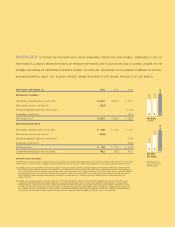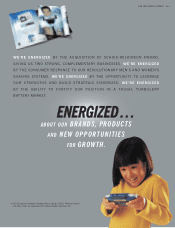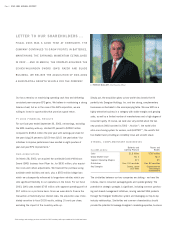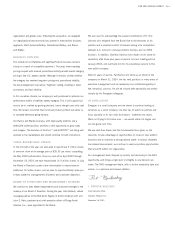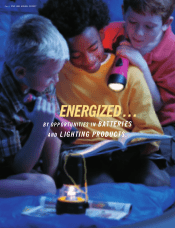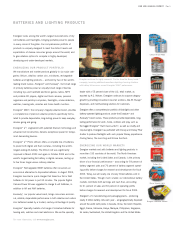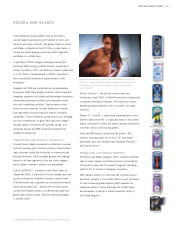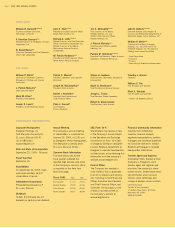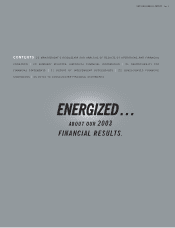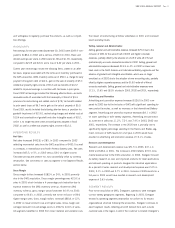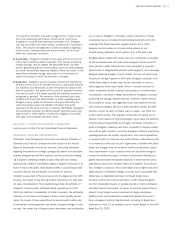Energizer 2003 Annual Report Download - page 12
Download and view the complete annual report
Please find page 12 of the 2003 Energizer annual report below. You can navigate through the pages in the report by either clicking on the pages listed below, or by using the keyword search tool below to find specific information within the annual report.Page 10 ENR 2003 ANNUAL REPORT
The following discussion is a summary of the key factors management
considers necessary in reviewing Energizer Holdings, Inc.’s (Energizer)
historical basis results of operations, operating segment results, and
liquidity and capital resources. This discussion should be read in con-
junction with the Consolidated Financial Statements and related notes.
BATTERY BUSINESS OVERVIEW
Energizer is one of the world’s largest manufacturers of primary batteries
and flashlights and a global leader in the dynamic business of providing
portable power. Energizer manufactures and/or markets a complete
line of primary alkaline and carbon zinc, miniature and rechargeable
batteries primarily under the brands Energizer®e2®
, Energizer ®and
Eveready ®,as well as specialty photo lithium batteries, flashlights and
other lighting products.
There has been a continuing shift in consumer preference from carbon
zinc batteries to higher-power, higher-priced alkaline and other more
advanced batteries. Alkaline batteries are the predominant primary bat-
tery in most parts of the world except Asia and Africa. However, carbon
zinc batteries continue to play a major role in less developed countries
throughout the world and offer Energizer market position in those coun-
tries. Energizer uses its full portfolio of products to meet consumer needs.
Energizer and its battery and lighting products subsidiaries operate
21 manufacturing and packaging facilities in 14 countries on four conti-
nents. Its products are marketed and sold in more than 150 countries
primarily through a direct sales force, and also through distributors, to
mass merchandisers, wholesalers and other customers.
The battery category continues to be highly competitive as manufacturers
compete for consumer acceptance and retail shelf space. Overall primary
battery consumption has been increasing for many years, however eco-
nomic weakness in particular world areas and inventory reductions by
retailers have moderated unit sales growth. Over the last three years, cate-
gory dollar sales in the United States have lagged unit sales as consumer
purchases have shifted to larger pack sizes, list prices have been reduced
and/or promotional discounting has deepened as competitors attempt to
gain or protect share. In late fiscal 2003, category pricing in the United
States has begun to stabilize and promotional discounting has moderated.
Energizer estimates its share of the total United States retail alkaline
market was approximately 31% in 2003 and 32% in 2002 and 2001.
Retail outlets experiencing the strongest battery category growth in the
United States include mass merchandisers’ super center format, home
centers and dollar stores, while traditional outlets such as food, drug and
hardware declined. Outside the United States, retail growth is generally in
larger scale, multi-national outlets. Wal-Mart Stores, Inc. and its sub-
sidiaries is Energizer’s largest customer. Energizer is well positioned to
meet the needs of customer and consumer demands in these formats,
leveraging category expertise, retail understanding and its portfolio of prod-
ucts to give Energizer a strong presence in each of the retail channels.
Internationally, economic conditions and currency valuations, relative
to the U.S. dollar, have improved in 2003, resulting in improved
International Battery segment results. The strengthening of the euro has
been a significant benefit to Energizer in 2003. Currency valuation was
generally unfavorable to Energizer during 2001 and 2002. In 2002, the
Argentine peso value declined in excess of 70%, but has improved mod-
estly in 2003. A significant portion of Energizer’s product cost is more
closely tied to the U.S. dollar than to the local currencies in which the
product is sold. As such, currency devaluation relative to the U.S. dollar
reduces margins to the extent increased costs in local currency terms
are not offset by local currency price increases. Conversely, strengthen-
ing currencies relative to the U.S. dollar are generally favorable to
Energizer’s profit margins. Changes in the value of local currencies
may continue to impact segment profitability in the future.
RAZORS AND BLADES BUSINESS OVERVIEW
On March 28, 2003, Energizer acquired the worldwide Schick-
Wilkinson Sword (SWS) business from Pfizer, Inc. SWS is the second
largest manufacturer and marketer of men’s and women’s wet shave
products in the world. SWS operates five manufacturing facilities world-
wide and its products are marketed in over 80 countries, accounting for
an estimated 18% market share of the global wet shaving business.
Its primary markets are Europe, the United States and Japan.
Energizer views the wet shave products category as attractive within
the consumer products industry due to the limited number of manufac-
turers, the high degree of consumer loyalty and the ability to improve
pricing through innovation. Energizer believes SWS has high-quality
products, a defensible market position and the opportunity to grow sales
and margins. The SWS business is compatible with Energizer’s business
in terms of common customers, distribution channels and geographic
presence, which should provide opportunities to leverage Energizer’s
marketing expertise, business organization and scale globally.
In 2003, SWS launched two major new products. The Intuition™
women’s shaving system was launched in the United States in April
2003 and QUATTRO™ was launched in the United States and part
of Europe in September 2003. Initial acceptance of these products by
retailers and consumers has been encouraging. Ultimate success of
these product launches will depend on long-term consumer acceptance
ENERGIZER HOLDINGS, INC.
MANAGEMENT’S DISCUSSION AND ANALYSIS OF RESULTS OF OPERATIONS AND FINANCIAL CONDITION
(Dollars in millions except per share and percentage data)


